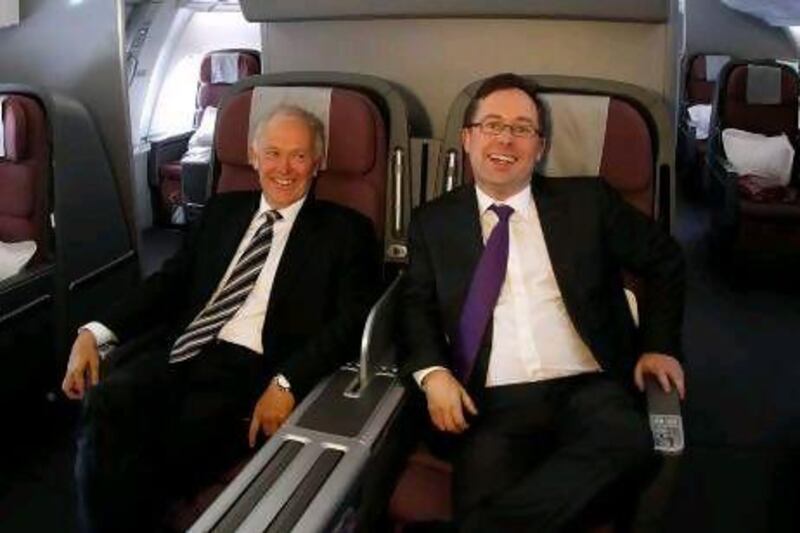The Emirates Airline alliance with Qantas is a significant departure from its past policy of shunning closer commercial ties with rivals.
But yesterday, after months of negotiations and endless speculation, the two airlines unveiled the terms of a 10-year alliance on the so-called "kangaroo route" between Australia and Europe, due to begin next April.
"A robust economy, strong dollar and Australia's clever tourism campaigns [have] combined to make [Australia] a key growth market for all future-facing airlines of the world," is how Tim Clark, the chief executive and president of Emirates, explained his volte-face on partnerships yesterday.
Although Emirates has codeshares with more than a dozen other airlines, until now its policy towards alliances has been hostile. But the influential aviation intelligence analyst Capa - Centre for Aviation, said the deal fitted the Dubai carrier's strategy.
"Emirates' size has afforded it the opportunity to go along its growth trajectory on its own," it noted. "The arrangement with Qantas is significantly larger than any of those [it] pursued before [but] we see Emirates [has] chosen a … sound path."
The kangaroo route is one of the most competitive in the industry. Last month, Etihad Airways increased its shareholding in Virgin Australia to 10 per cent. Together the carriers now operate 24 flights per week between Australia and Abu Dhabi, offering travellers a combined network of more than 285 global destinations.
For Emirates, this deal will help to fulfil its goal of offering round-the-world services, using Qantas for trans-Pacific flights. The link also offers Emirates greater access to Australia's booming domestic routes, buoyed by the country's resources-driven economy and dominated by the Australian carrier.
It will also wrongfoot rivals. The deal ends Qantas' partnership with British Airways (BA) between Australia and London that had run for almost two decades.
Yesterday, Willie Walsh, the chief executive of BA's parent company International Airlines Group, said the termination of the joint services agreement with Qantas would not affect earnings. But he added BA was now "talking to a number of airlines about alternative options".
Singapore Airlines (SIA) will also be hit, according to Bank of America Merrill Lynch. SIA derives just over a quarter of its entire passenger revenues from the kangaroo route, where it offers more than 40,000 outbound seats to hubs in Asia and the Middle East.
At more than 55,000 weekly seats, Qantas-Emirates will offer more destinations, frequencies and alternate routes than their Asian rival, Bank of America Merrill Lynch said.
Under the deal, Qantas will begin services to Dubai from Melbourne and Sydney using Airbus A380s. These services will continue to London. The carrier will halt routes to Europe via Singapore and end flights to Frankfurt. Between the two airlines there will be 98 weekly services between Australia and Dubai.
The agreement will also give Qantas passengers one-stop services to more than 70 Emirates destinations in Europe, the Middle East and Africa. Emirates will gain access to Qantas' domestic network covering more than 50 destinations. The two airlines will also coordinate Australia-New Zealand and Australia-South East Asia services.
"A key objective is to make Qantas International strong and viable and bring it back to profitability," said Alan Joyce, the Qantas chief executive. "This partnership will help us do that."
Battered by rising fuel prices and competition from carriers in the Middle East and Asia, Qantas last month posted its first annual loss since it was privatised in 1995. It also shelved an order for 35 Boeing 787 Dreamliners. "We believe an Emirates deal is the missing piece in the earnings bridge recovering mainline international for the A$450 million [Dh1.69 billion] loss in the 2012 to break-even by the end of the 2014 financial year," said Russell Shaw, an analyst at Macquarie investment bank.
The alliance could add between A$80m and A$90m to Qantas' earnings, he added.
Mr Clark, however, took a more strategic view. He hailed the deal as a step-change that could mark the beginning of the end for the alliance agreements that dominate the global airline industry.
"This arrangement with Qantas is perhaps the start of a new thinking as to how the airline industry understands traffic flows across the planet," he said.
"This deal will have a fairly seismic shift on the alliances."
twitter: Follow and share our breaking business news. Follow us
iPad users can read the digital edition of business section as it was printed via our e-reader app. Click here





